Business Research 1: Nepal Housing Price Impact on Households
VerifiedAdded on 2023/06/08
|12
|2862
|143
Report
AI Summary
This business research report examines the multifaceted impacts of escalating housing prices on low and medium-income households in Nepal. The study delves into both the social and economic consequences, highlighting the challenges faced by a population grappling with poverty and limited resources. The research explores how rising housing costs contribute to issues such as poor living standards, homelessness, increased disease vulnerability, and social inequality. Economically, the report analyzes how expensive housing can discourage investment, potentially hindering economic growth, while also acknowledging the potential for increased revenue and infrastructure development. The report also highlights the negative impacts such as reduced workforce productivity, and increased healthcare costs. The conclusion emphasizes the need for affordable housing solutions to mitigate the adverse effects and foster a more equitable society in Nepal.
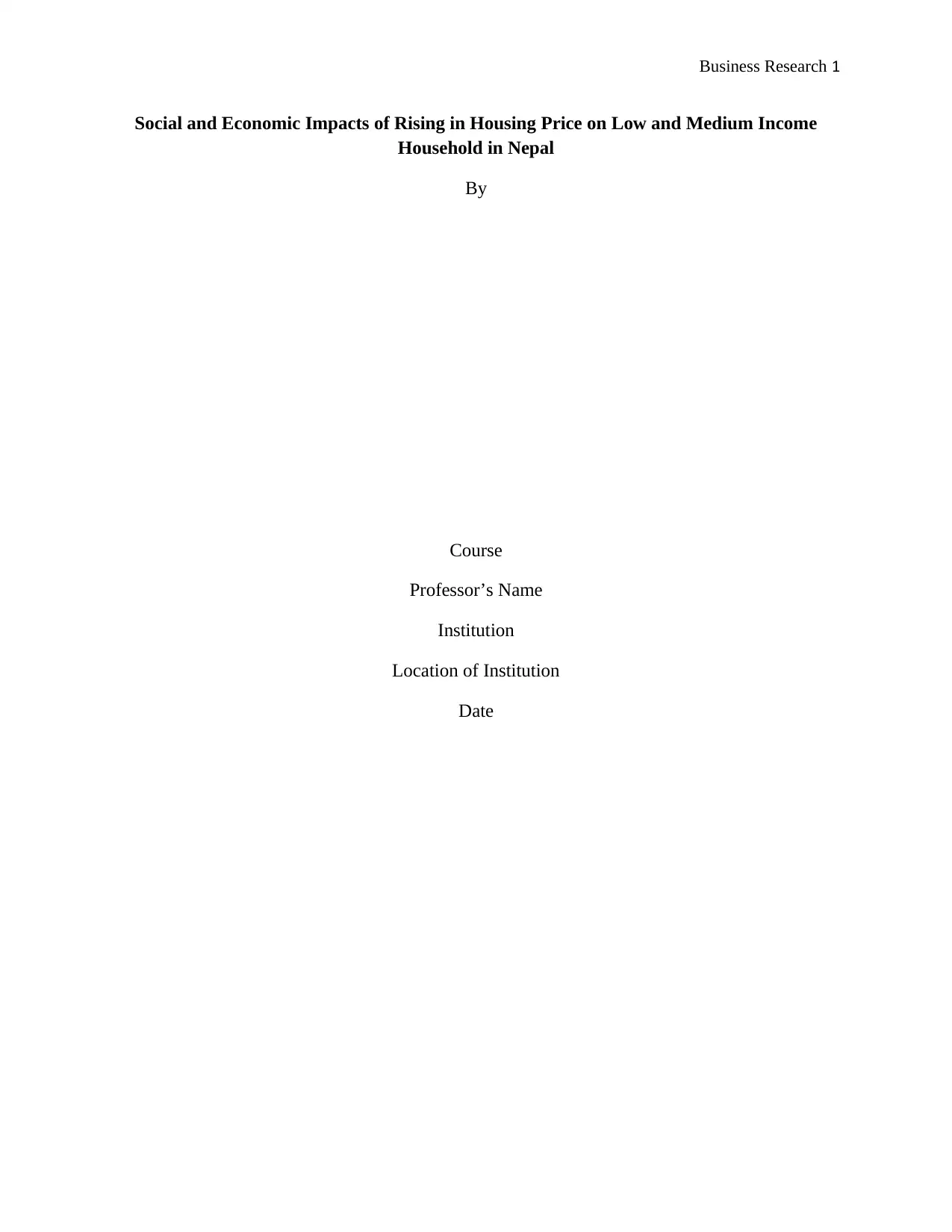
Business Research 1
Social and Economic Impacts of Rising in Housing Price on Low and Medium Income
Household in Nepal
By
Course
Professor’s Name
Institution
Location of Institution
Date
Social and Economic Impacts of Rising in Housing Price on Low and Medium Income
Household in Nepal
By
Course
Professor’s Name
Institution
Location of Institution
Date
Paraphrase This Document
Need a fresh take? Get an instant paraphrase of this document with our AI Paraphraser
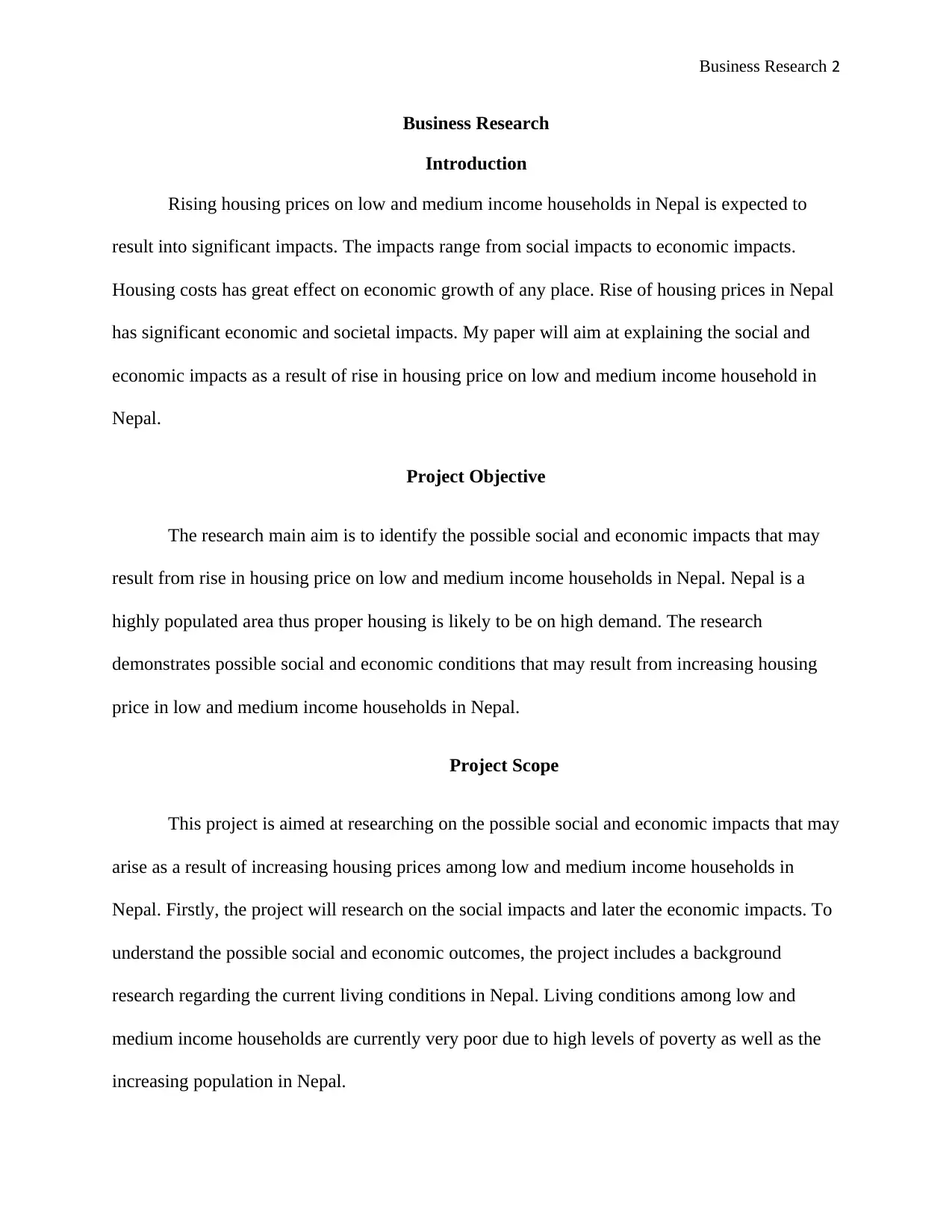
Business Research 2
Business Research
Introduction
Rising housing prices on low and medium income households in Nepal is expected to
result into significant impacts. The impacts range from social impacts to economic impacts.
Housing costs has great effect on economic growth of any place. Rise of housing prices in Nepal
has significant economic and societal impacts. My paper will aim at explaining the social and
economic impacts as a result of rise in housing price on low and medium income household in
Nepal.
Project Objective
The research main aim is to identify the possible social and economic impacts that may
result from rise in housing price on low and medium income households in Nepal. Nepal is a
highly populated area thus proper housing is likely to be on high demand. The research
demonstrates possible social and economic conditions that may result from increasing housing
price in low and medium income households in Nepal.
Project Scope
This project is aimed at researching on the possible social and economic impacts that may
arise as a result of increasing housing prices among low and medium income households in
Nepal. Firstly, the project will research on the social impacts and later the economic impacts. To
understand the possible social and economic outcomes, the project includes a background
research regarding the current living conditions in Nepal. Living conditions among low and
medium income households are currently very poor due to high levels of poverty as well as the
increasing population in Nepal.
Business Research
Introduction
Rising housing prices on low and medium income households in Nepal is expected to
result into significant impacts. The impacts range from social impacts to economic impacts.
Housing costs has great effect on economic growth of any place. Rise of housing prices in Nepal
has significant economic and societal impacts. My paper will aim at explaining the social and
economic impacts as a result of rise in housing price on low and medium income household in
Nepal.
Project Objective
The research main aim is to identify the possible social and economic impacts that may
result from rise in housing price on low and medium income households in Nepal. Nepal is a
highly populated area thus proper housing is likely to be on high demand. The research
demonstrates possible social and economic conditions that may result from increasing housing
price in low and medium income households in Nepal.
Project Scope
This project is aimed at researching on the possible social and economic impacts that may
arise as a result of increasing housing prices among low and medium income households in
Nepal. Firstly, the project will research on the social impacts and later the economic impacts. To
understand the possible social and economic outcomes, the project includes a background
research regarding the current living conditions in Nepal. Living conditions among low and
medium income households are currently very poor due to high levels of poverty as well as the
increasing population in Nepal.
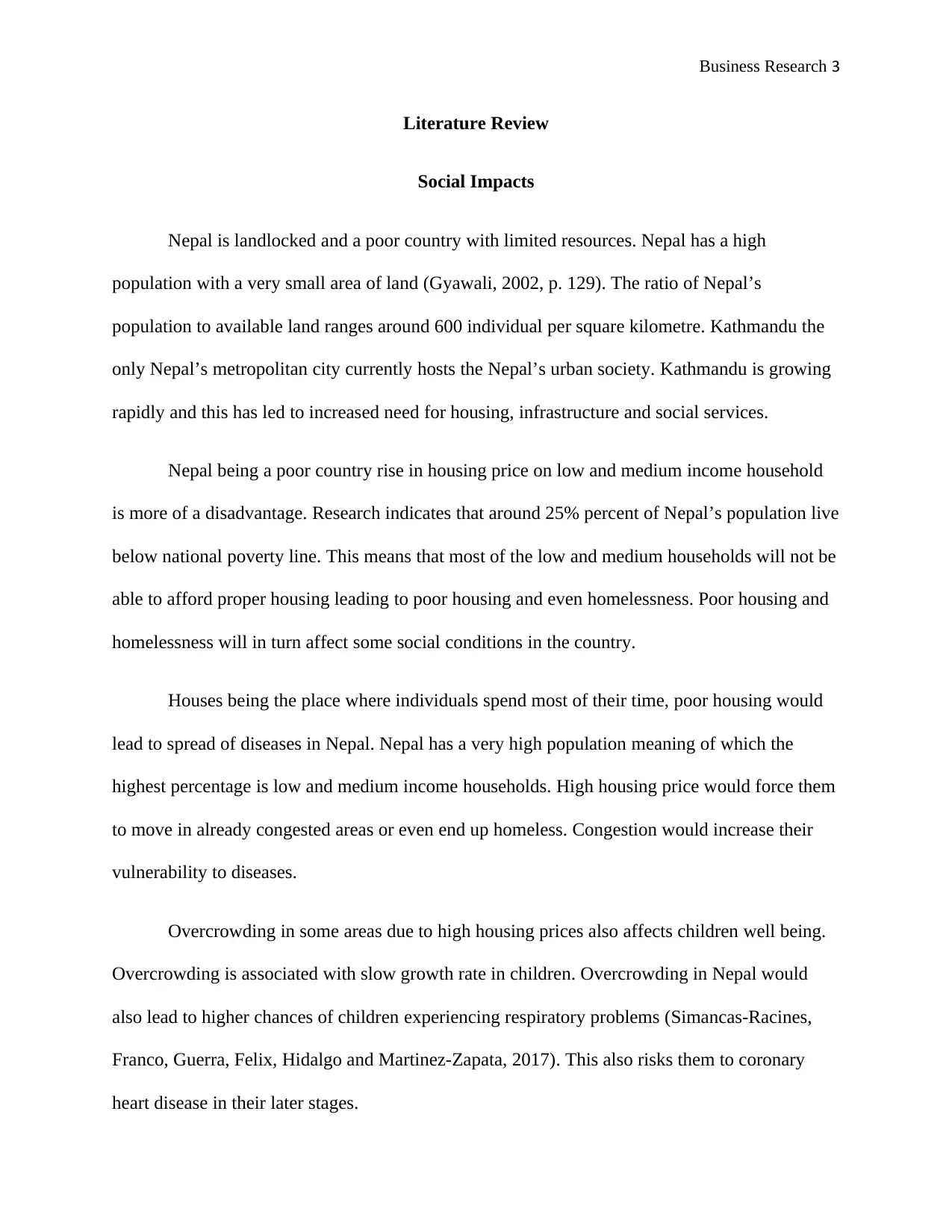
Business Research 3
Literature Review
Social Impacts
Nepal is landlocked and a poor country with limited resources. Nepal has a high
population with a very small area of land (Gyawali, 2002, p. 129). The ratio of Nepal’s
population to available land ranges around 600 individual per square kilometre. Kathmandu the
only Nepal’s metropolitan city currently hosts the Nepal’s urban society. Kathmandu is growing
rapidly and this has led to increased need for housing, infrastructure and social services.
Nepal being a poor country rise in housing price on low and medium income household
is more of a disadvantage. Research indicates that around 25% percent of Nepal’s population live
below national poverty line. This means that most of the low and medium households will not be
able to afford proper housing leading to poor housing and even homelessness. Poor housing and
homelessness will in turn affect some social conditions in the country.
Houses being the place where individuals spend most of their time, poor housing would
lead to spread of diseases in Nepal. Nepal has a very high population meaning of which the
highest percentage is low and medium income households. High housing price would force them
to move in already congested areas or even end up homeless. Congestion would increase their
vulnerability to diseases.
Overcrowding in some areas due to high housing prices also affects children well being.
Overcrowding is associated with slow growth rate in children. Overcrowding in Nepal would
also lead to higher chances of children experiencing respiratory problems (Simancas‐Racines,
Franco, Guerra, Felix, Hidalgo and Martinez‐Zapata, 2017). This also risks them to coronary
heart disease in their later stages.
Literature Review
Social Impacts
Nepal is landlocked and a poor country with limited resources. Nepal has a high
population with a very small area of land (Gyawali, 2002, p. 129). The ratio of Nepal’s
population to available land ranges around 600 individual per square kilometre. Kathmandu the
only Nepal’s metropolitan city currently hosts the Nepal’s urban society. Kathmandu is growing
rapidly and this has led to increased need for housing, infrastructure and social services.
Nepal being a poor country rise in housing price on low and medium income household
is more of a disadvantage. Research indicates that around 25% percent of Nepal’s population live
below national poverty line. This means that most of the low and medium households will not be
able to afford proper housing leading to poor housing and even homelessness. Poor housing and
homelessness will in turn affect some social conditions in the country.
Houses being the place where individuals spend most of their time, poor housing would
lead to spread of diseases in Nepal. Nepal has a very high population meaning of which the
highest percentage is low and medium income households. High housing price would force them
to move in already congested areas or even end up homeless. Congestion would increase their
vulnerability to diseases.
Overcrowding in some areas due to high housing prices also affects children well being.
Overcrowding is associated with slow growth rate in children. Overcrowding in Nepal would
also lead to higher chances of children experiencing respiratory problems (Simancas‐Racines,
Franco, Guerra, Felix, Hidalgo and Martinez‐Zapata, 2017). This also risks them to coronary
heart disease in their later stages.
⊘ This is a preview!⊘
Do you want full access?
Subscribe today to unlock all pages.

Trusted by 1+ million students worldwide
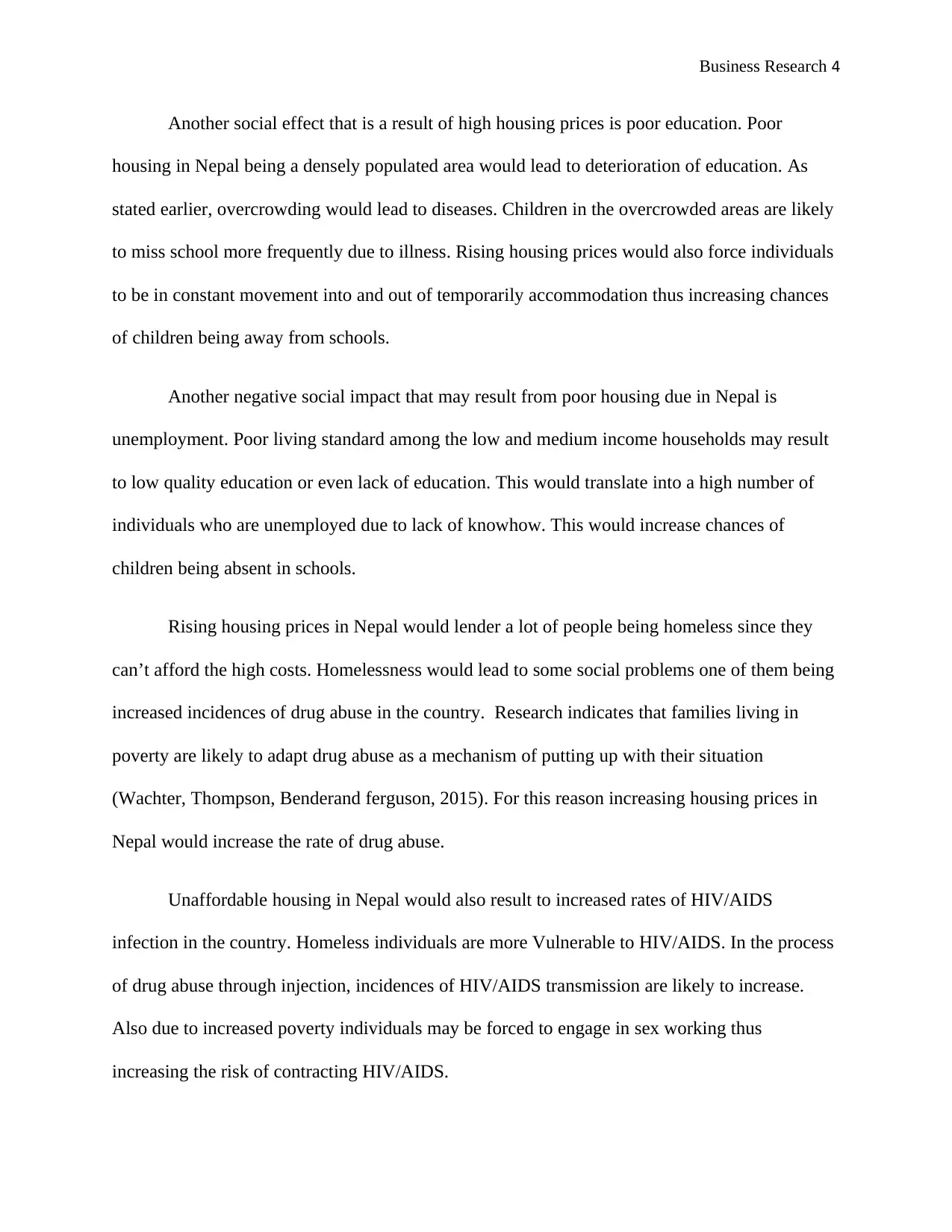
Business Research 4
Another social effect that is a result of high housing prices is poor education. Poor
housing in Nepal being a densely populated area would lead to deterioration of education. As
stated earlier, overcrowding would lead to diseases. Children in the overcrowded areas are likely
to miss school more frequently due to illness. Rising housing prices would also force individuals
to be in constant movement into and out of temporarily accommodation thus increasing chances
of children being away from schools.
Another negative social impact that may result from poor housing due in Nepal is
unemployment. Poor living standard among the low and medium income households may result
to low quality education or even lack of education. This would translate into a high number of
individuals who are unemployed due to lack of knowhow. This would increase chances of
children being absent in schools.
Rising housing prices in Nepal would lender a lot of people being homeless since they
can’t afford the high costs. Homelessness would lead to some social problems one of them being
increased incidences of drug abuse in the country. Research indicates that families living in
poverty are likely to adapt drug abuse as a mechanism of putting up with their situation
(Wachter, Thompson, Benderand ferguson, 2015). For this reason increasing housing prices in
Nepal would increase the rate of drug abuse.
Unaffordable housing in Nepal would also result to increased rates of HIV/AIDS
infection in the country. Homeless individuals are more Vulnerable to HIV/AIDS. In the process
of drug abuse through injection, incidences of HIV/AIDS transmission are likely to increase.
Also due to increased poverty individuals may be forced to engage in sex working thus
increasing the risk of contracting HIV/AIDS.
Another social effect that is a result of high housing prices is poor education. Poor
housing in Nepal being a densely populated area would lead to deterioration of education. As
stated earlier, overcrowding would lead to diseases. Children in the overcrowded areas are likely
to miss school more frequently due to illness. Rising housing prices would also force individuals
to be in constant movement into and out of temporarily accommodation thus increasing chances
of children being away from schools.
Another negative social impact that may result from poor housing due in Nepal is
unemployment. Poor living standard among the low and medium income households may result
to low quality education or even lack of education. This would translate into a high number of
individuals who are unemployed due to lack of knowhow. This would increase chances of
children being absent in schools.
Rising housing prices in Nepal would lender a lot of people being homeless since they
can’t afford the high costs. Homelessness would lead to some social problems one of them being
increased incidences of drug abuse in the country. Research indicates that families living in
poverty are likely to adapt drug abuse as a mechanism of putting up with their situation
(Wachter, Thompson, Benderand ferguson, 2015). For this reason increasing housing prices in
Nepal would increase the rate of drug abuse.
Unaffordable housing in Nepal would also result to increased rates of HIV/AIDS
infection in the country. Homeless individuals are more Vulnerable to HIV/AIDS. In the process
of drug abuse through injection, incidences of HIV/AIDS transmission are likely to increase.
Also due to increased poverty individuals may be forced to engage in sex working thus
increasing the risk of contracting HIV/AIDS.
Paraphrase This Document
Need a fresh take? Get an instant paraphrase of this document with our AI Paraphraser
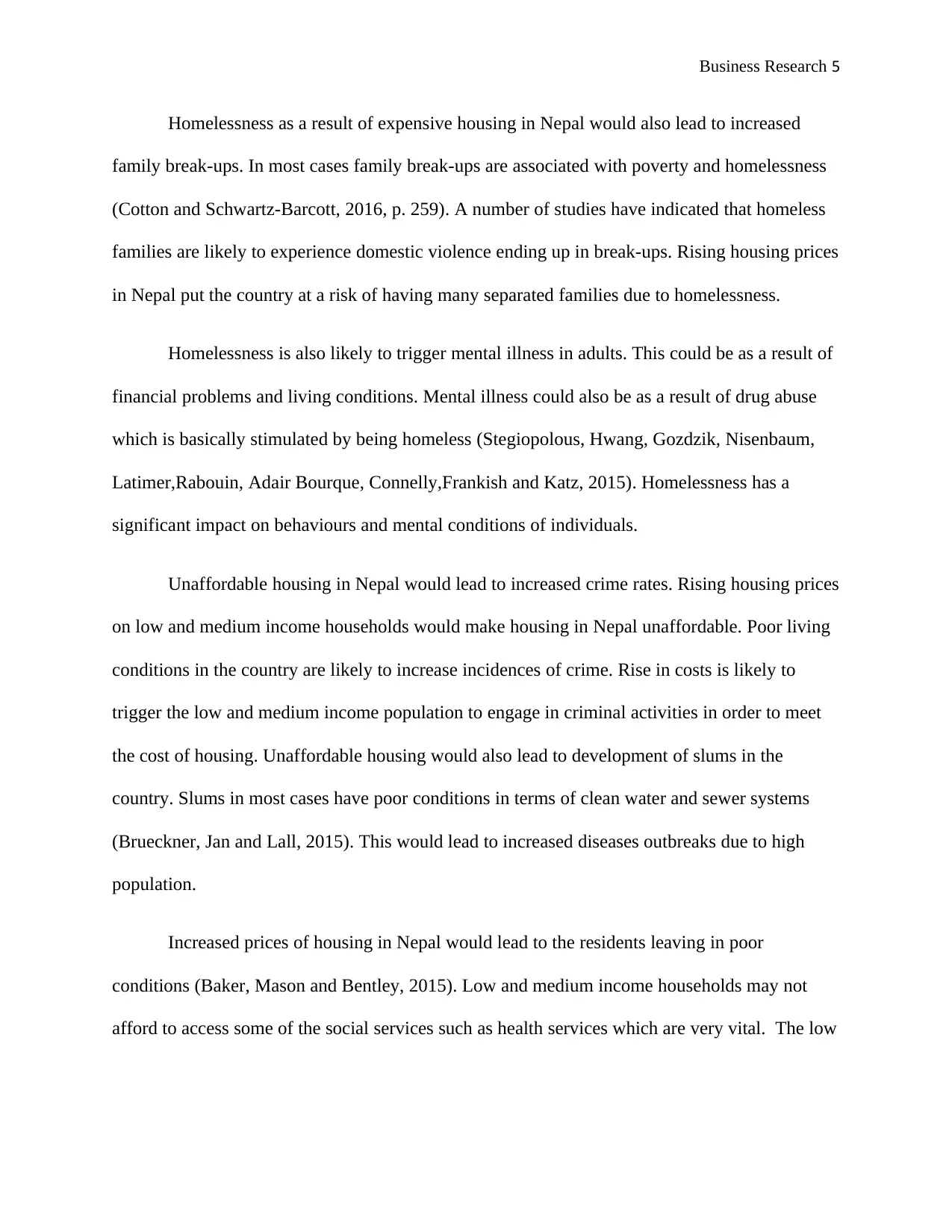
Business Research 5
Homelessness as a result of expensive housing in Nepal would also lead to increased
family break-ups. In most cases family break-ups are associated with poverty and homelessness
(Cotton and Schwartz-Barcott, 2016, p. 259). A number of studies have indicated that homeless
families are likely to experience domestic violence ending up in break-ups. Rising housing prices
in Nepal put the country at a risk of having many separated families due to homelessness.
Homelessness is also likely to trigger mental illness in adults. This could be as a result of
financial problems and living conditions. Mental illness could also be as a result of drug abuse
which is basically stimulated by being homeless (Stegiopolous, Hwang, Gozdzik, Nisenbaum,
Latimer,Rabouin, Adair Bourque, Connelly,Frankish and Katz, 2015). Homelessness has a
significant impact on behaviours and mental conditions of individuals.
Unaffordable housing in Nepal would lead to increased crime rates. Rising housing prices
on low and medium income households would make housing in Nepal unaffordable. Poor living
conditions in the country are likely to increase incidences of crime. Rise in costs is likely to
trigger the low and medium income population to engage in criminal activities in order to meet
the cost of housing. Unaffordable housing would also lead to development of slums in the
country. Slums in most cases have poor conditions in terms of clean water and sewer systems
(Brueckner, Jan and Lall, 2015). This would lead to increased diseases outbreaks due to high
population.
Increased prices of housing in Nepal would lead to the residents leaving in poor
conditions (Baker, Mason and Bentley, 2015). Low and medium income households may not
afford to access some of the social services such as health services which are very vital. The low
Homelessness as a result of expensive housing in Nepal would also lead to increased
family break-ups. In most cases family break-ups are associated with poverty and homelessness
(Cotton and Schwartz-Barcott, 2016, p. 259). A number of studies have indicated that homeless
families are likely to experience domestic violence ending up in break-ups. Rising housing prices
in Nepal put the country at a risk of having many separated families due to homelessness.
Homelessness is also likely to trigger mental illness in adults. This could be as a result of
financial problems and living conditions. Mental illness could also be as a result of drug abuse
which is basically stimulated by being homeless (Stegiopolous, Hwang, Gozdzik, Nisenbaum,
Latimer,Rabouin, Adair Bourque, Connelly,Frankish and Katz, 2015). Homelessness has a
significant impact on behaviours and mental conditions of individuals.
Unaffordable housing in Nepal would lead to increased crime rates. Rising housing prices
on low and medium income households would make housing in Nepal unaffordable. Poor living
conditions in the country are likely to increase incidences of crime. Rise in costs is likely to
trigger the low and medium income population to engage in criminal activities in order to meet
the cost of housing. Unaffordable housing would also lead to development of slums in the
country. Slums in most cases have poor conditions in terms of clean water and sewer systems
(Brueckner, Jan and Lall, 2015). This would lead to increased diseases outbreaks due to high
population.
Increased prices of housing in Nepal would lead to the residents leaving in poor
conditions (Baker, Mason and Bentley, 2015). Low and medium income households may not
afford to access some of the social services such as health services which are very vital. The low
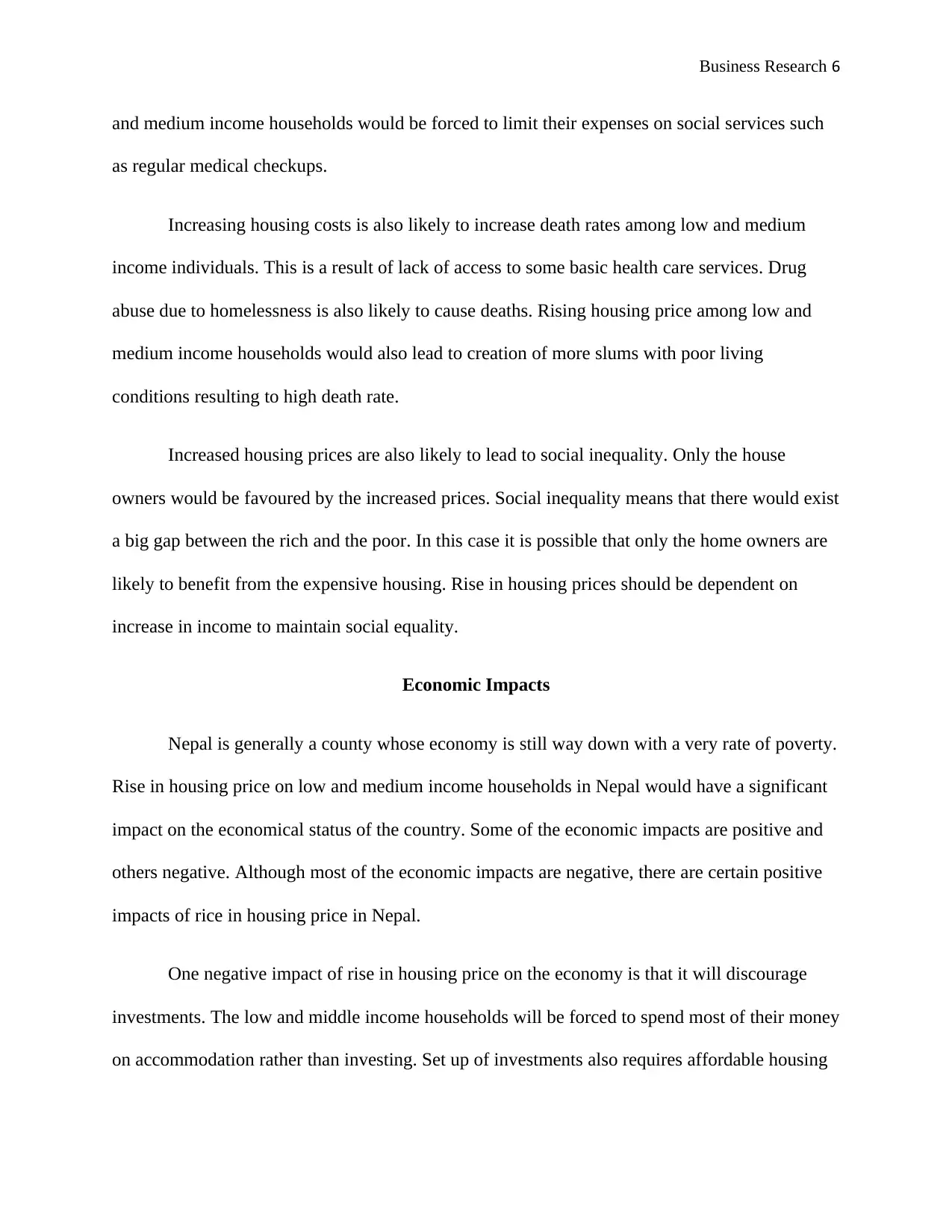
Business Research 6
and medium income households would be forced to limit their expenses on social services such
as regular medical checkups.
Increasing housing costs is also likely to increase death rates among low and medium
income individuals. This is a result of lack of access to some basic health care services. Drug
abuse due to homelessness is also likely to cause deaths. Rising housing price among low and
medium income households would also lead to creation of more slums with poor living
conditions resulting to high death rate.
Increased housing prices are also likely to lead to social inequality. Only the house
owners would be favoured by the increased prices. Social inequality means that there would exist
a big gap between the rich and the poor. In this case it is possible that only the home owners are
likely to benefit from the expensive housing. Rise in housing prices should be dependent on
increase in income to maintain social equality.
Economic Impacts
Nepal is generally a county whose economy is still way down with a very rate of poverty.
Rise in housing price on low and medium income households in Nepal would have a significant
impact on the economical status of the country. Some of the economic impacts are positive and
others negative. Although most of the economic impacts are negative, there are certain positive
impacts of rice in housing price in Nepal.
One negative impact of rise in housing price on the economy is that it will discourage
investments. The low and middle income households will be forced to spend most of their money
on accommodation rather than investing. Set up of investments also requires affordable housing
and medium income households would be forced to limit their expenses on social services such
as regular medical checkups.
Increasing housing costs is also likely to increase death rates among low and medium
income individuals. This is a result of lack of access to some basic health care services. Drug
abuse due to homelessness is also likely to cause deaths. Rising housing price among low and
medium income households would also lead to creation of more slums with poor living
conditions resulting to high death rate.
Increased housing prices are also likely to lead to social inequality. Only the house
owners would be favoured by the increased prices. Social inequality means that there would exist
a big gap between the rich and the poor. In this case it is possible that only the home owners are
likely to benefit from the expensive housing. Rise in housing prices should be dependent on
increase in income to maintain social equality.
Economic Impacts
Nepal is generally a county whose economy is still way down with a very rate of poverty.
Rise in housing price on low and medium income households in Nepal would have a significant
impact on the economical status of the country. Some of the economic impacts are positive and
others negative. Although most of the economic impacts are negative, there are certain positive
impacts of rice in housing price in Nepal.
One negative impact of rise in housing price on the economy is that it will discourage
investments. The low and middle income households will be forced to spend most of their money
on accommodation rather than investing. Set up of investments also requires affordable housing
⊘ This is a preview!⊘
Do you want full access?
Subscribe today to unlock all pages.

Trusted by 1+ million students worldwide
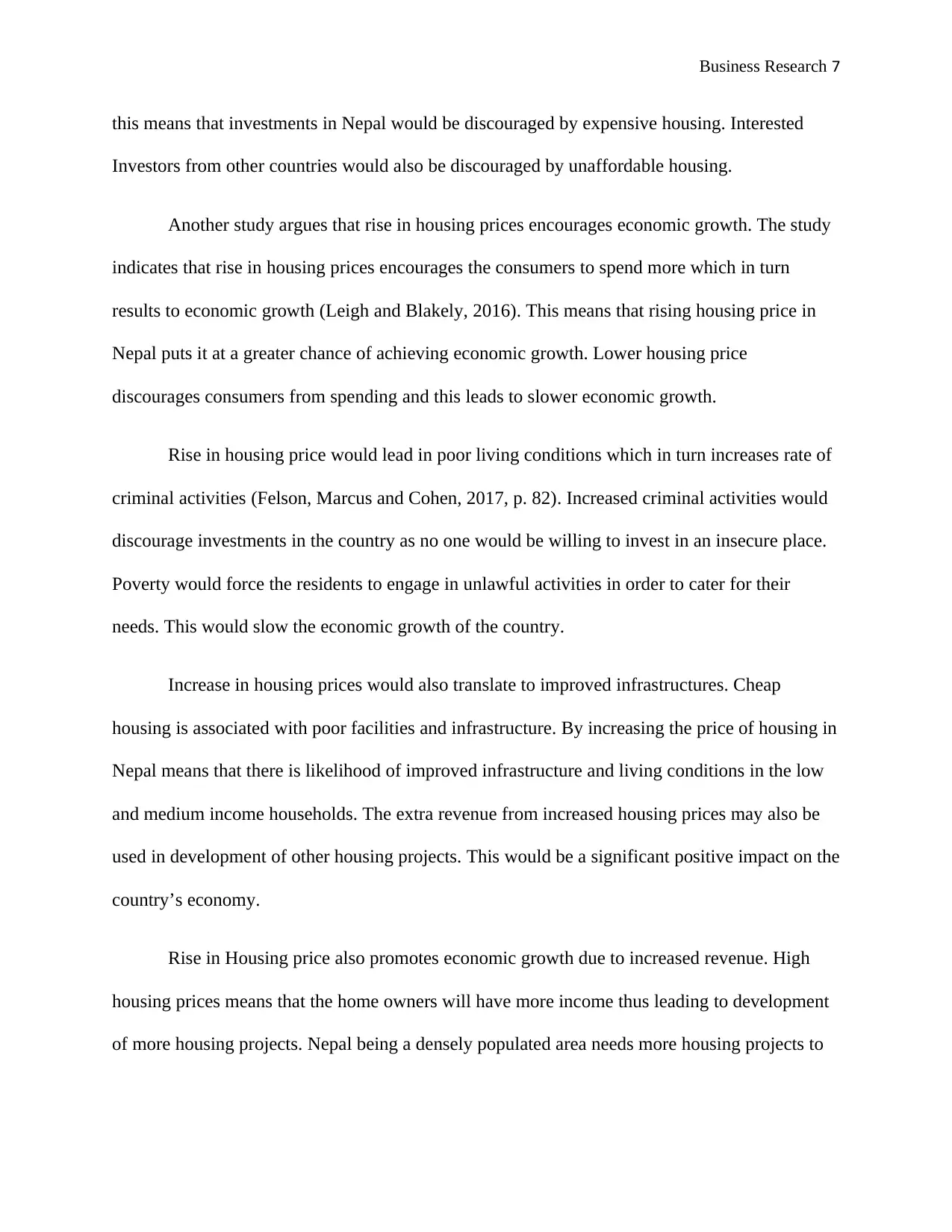
Business Research 7
this means that investments in Nepal would be discouraged by expensive housing. Interested
Investors from other countries would also be discouraged by unaffordable housing.
Another study argues that rise in housing prices encourages economic growth. The study
indicates that rise in housing prices encourages the consumers to spend more which in turn
results to economic growth (Leigh and Blakely, 2016). This means that rising housing price in
Nepal puts it at a greater chance of achieving economic growth. Lower housing price
discourages consumers from spending and this leads to slower economic growth.
Rise in housing price would lead in poor living conditions which in turn increases rate of
criminal activities (Felson, Marcus and Cohen, 2017, p. 82). Increased criminal activities would
discourage investments in the country as no one would be willing to invest in an insecure place.
Poverty would force the residents to engage in unlawful activities in order to cater for their
needs. This would slow the economic growth of the country.
Increase in housing prices would also translate to improved infrastructures. Cheap
housing is associated with poor facilities and infrastructure. By increasing the price of housing in
Nepal means that there is likelihood of improved infrastructure and living conditions in the low
and medium income households. The extra revenue from increased housing prices may also be
used in development of other housing projects. This would be a significant positive impact on the
country’s economy.
Rise in Housing price also promotes economic growth due to increased revenue. High
housing prices means that the home owners will have more income thus leading to development
of more housing projects. Nepal being a densely populated area needs more housing projects to
this means that investments in Nepal would be discouraged by expensive housing. Interested
Investors from other countries would also be discouraged by unaffordable housing.
Another study argues that rise in housing prices encourages economic growth. The study
indicates that rise in housing prices encourages the consumers to spend more which in turn
results to economic growth (Leigh and Blakely, 2016). This means that rising housing price in
Nepal puts it at a greater chance of achieving economic growth. Lower housing price
discourages consumers from spending and this leads to slower economic growth.
Rise in housing price would lead in poor living conditions which in turn increases rate of
criminal activities (Felson, Marcus and Cohen, 2017, p. 82). Increased criminal activities would
discourage investments in the country as no one would be willing to invest in an insecure place.
Poverty would force the residents to engage in unlawful activities in order to cater for their
needs. This would slow the economic growth of the country.
Increase in housing prices would also translate to improved infrastructures. Cheap
housing is associated with poor facilities and infrastructure. By increasing the price of housing in
Nepal means that there is likelihood of improved infrastructure and living conditions in the low
and medium income households. The extra revenue from increased housing prices may also be
used in development of other housing projects. This would be a significant positive impact on the
country’s economy.
Rise in Housing price also promotes economic growth due to increased revenue. High
housing prices means that the home owners will have more income thus leading to development
of more housing projects. Nepal being a densely populated area needs more housing projects to
Paraphrase This Document
Need a fresh take? Get an instant paraphrase of this document with our AI Paraphraser
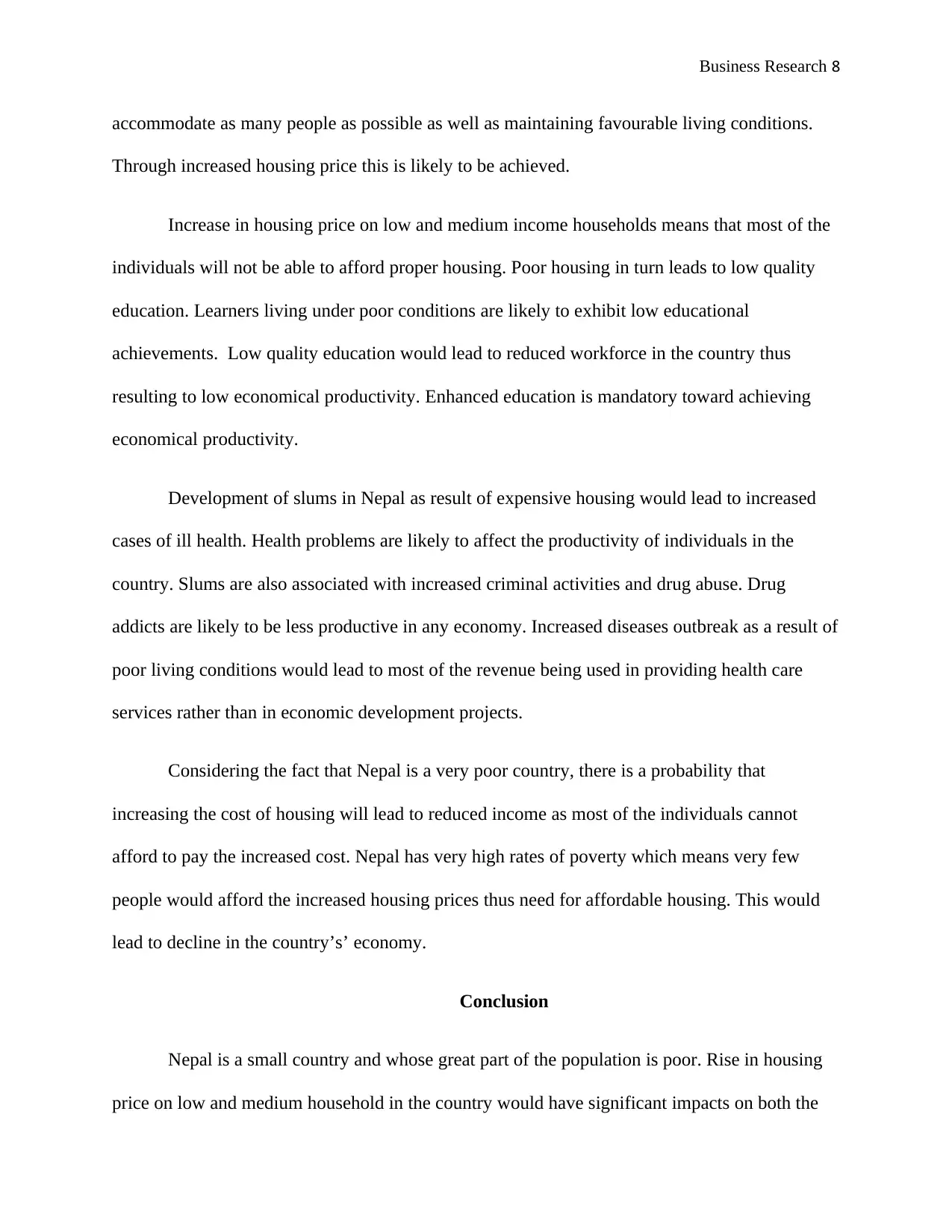
Business Research 8
accommodate as many people as possible as well as maintaining favourable living conditions.
Through increased housing price this is likely to be achieved.
Increase in housing price on low and medium income households means that most of the
individuals will not be able to afford proper housing. Poor housing in turn leads to low quality
education. Learners living under poor conditions are likely to exhibit low educational
achievements. Low quality education would lead to reduced workforce in the country thus
resulting to low economical productivity. Enhanced education is mandatory toward achieving
economical productivity.
Development of slums in Nepal as result of expensive housing would lead to increased
cases of ill health. Health problems are likely to affect the productivity of individuals in the
country. Slums are also associated with increased criminal activities and drug abuse. Drug
addicts are likely to be less productive in any economy. Increased diseases outbreak as a result of
poor living conditions would lead to most of the revenue being used in providing health care
services rather than in economic development projects.
Considering the fact that Nepal is a very poor country, there is a probability that
increasing the cost of housing will lead to reduced income as most of the individuals cannot
afford to pay the increased cost. Nepal has very high rates of poverty which means very few
people would afford the increased housing prices thus need for affordable housing. This would
lead to decline in the country’s’ economy.
Conclusion
Nepal is a small country and whose great part of the population is poor. Rise in housing
price on low and medium household in the country would have significant impacts on both the
accommodate as many people as possible as well as maintaining favourable living conditions.
Through increased housing price this is likely to be achieved.
Increase in housing price on low and medium income households means that most of the
individuals will not be able to afford proper housing. Poor housing in turn leads to low quality
education. Learners living under poor conditions are likely to exhibit low educational
achievements. Low quality education would lead to reduced workforce in the country thus
resulting to low economical productivity. Enhanced education is mandatory toward achieving
economical productivity.
Development of slums in Nepal as result of expensive housing would lead to increased
cases of ill health. Health problems are likely to affect the productivity of individuals in the
country. Slums are also associated with increased criminal activities and drug abuse. Drug
addicts are likely to be less productive in any economy. Increased diseases outbreak as a result of
poor living conditions would lead to most of the revenue being used in providing health care
services rather than in economic development projects.
Considering the fact that Nepal is a very poor country, there is a probability that
increasing the cost of housing will lead to reduced income as most of the individuals cannot
afford to pay the increased cost. Nepal has very high rates of poverty which means very few
people would afford the increased housing prices thus need for affordable housing. This would
lead to decline in the country’s’ economy.
Conclusion
Nepal is a small country and whose great part of the population is poor. Rise in housing
price on low and medium household in the country would have significant impacts on both the
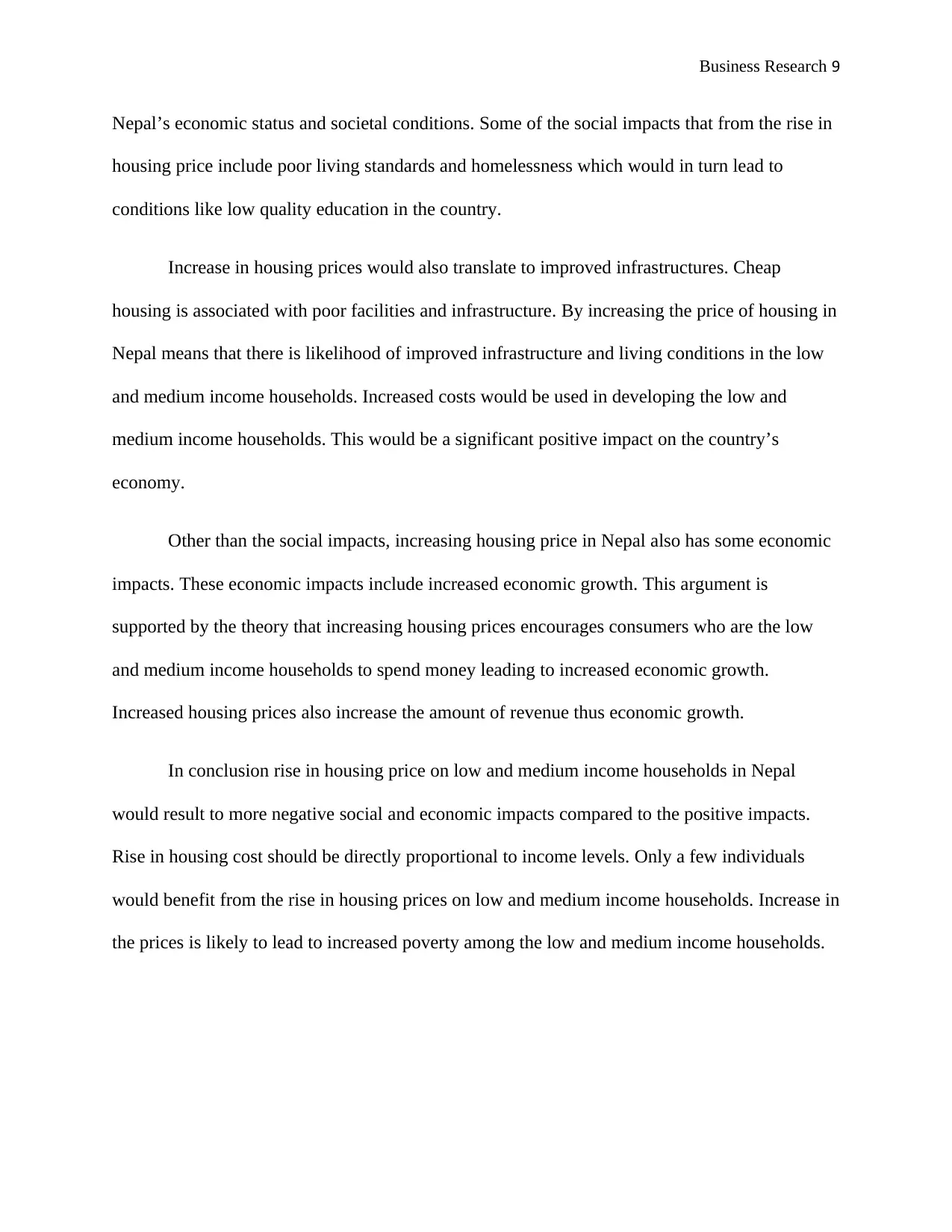
Business Research 9
Nepal’s economic status and societal conditions. Some of the social impacts that from the rise in
housing price include poor living standards and homelessness which would in turn lead to
conditions like low quality education in the country.
Increase in housing prices would also translate to improved infrastructures. Cheap
housing is associated with poor facilities and infrastructure. By increasing the price of housing in
Nepal means that there is likelihood of improved infrastructure and living conditions in the low
and medium income households. Increased costs would be used in developing the low and
medium income households. This would be a significant positive impact on the country’s
economy.
Other than the social impacts, increasing housing price in Nepal also has some economic
impacts. These economic impacts include increased economic growth. This argument is
supported by the theory that increasing housing prices encourages consumers who are the low
and medium income households to spend money leading to increased economic growth.
Increased housing prices also increase the amount of revenue thus economic growth.
In conclusion rise in housing price on low and medium income households in Nepal
would result to more negative social and economic impacts compared to the positive impacts.
Rise in housing cost should be directly proportional to income levels. Only a few individuals
would benefit from the rise in housing prices on low and medium income households. Increase in
the prices is likely to lead to increased poverty among the low and medium income households.
Nepal’s economic status and societal conditions. Some of the social impacts that from the rise in
housing price include poor living standards and homelessness which would in turn lead to
conditions like low quality education in the country.
Increase in housing prices would also translate to improved infrastructures. Cheap
housing is associated with poor facilities and infrastructure. By increasing the price of housing in
Nepal means that there is likelihood of improved infrastructure and living conditions in the low
and medium income households. Increased costs would be used in developing the low and
medium income households. This would be a significant positive impact on the country’s
economy.
Other than the social impacts, increasing housing price in Nepal also has some economic
impacts. These economic impacts include increased economic growth. This argument is
supported by the theory that increasing housing prices encourages consumers who are the low
and medium income households to spend money leading to increased economic growth.
Increased housing prices also increase the amount of revenue thus economic growth.
In conclusion rise in housing price on low and medium income households in Nepal
would result to more negative social and economic impacts compared to the positive impacts.
Rise in housing cost should be directly proportional to income levels. Only a few individuals
would benefit from the rise in housing prices on low and medium income households. Increase in
the prices is likely to lead to increased poverty among the low and medium income households.
⊘ This is a preview!⊘
Do you want full access?
Subscribe today to unlock all pages.

Trusted by 1+ million students worldwide
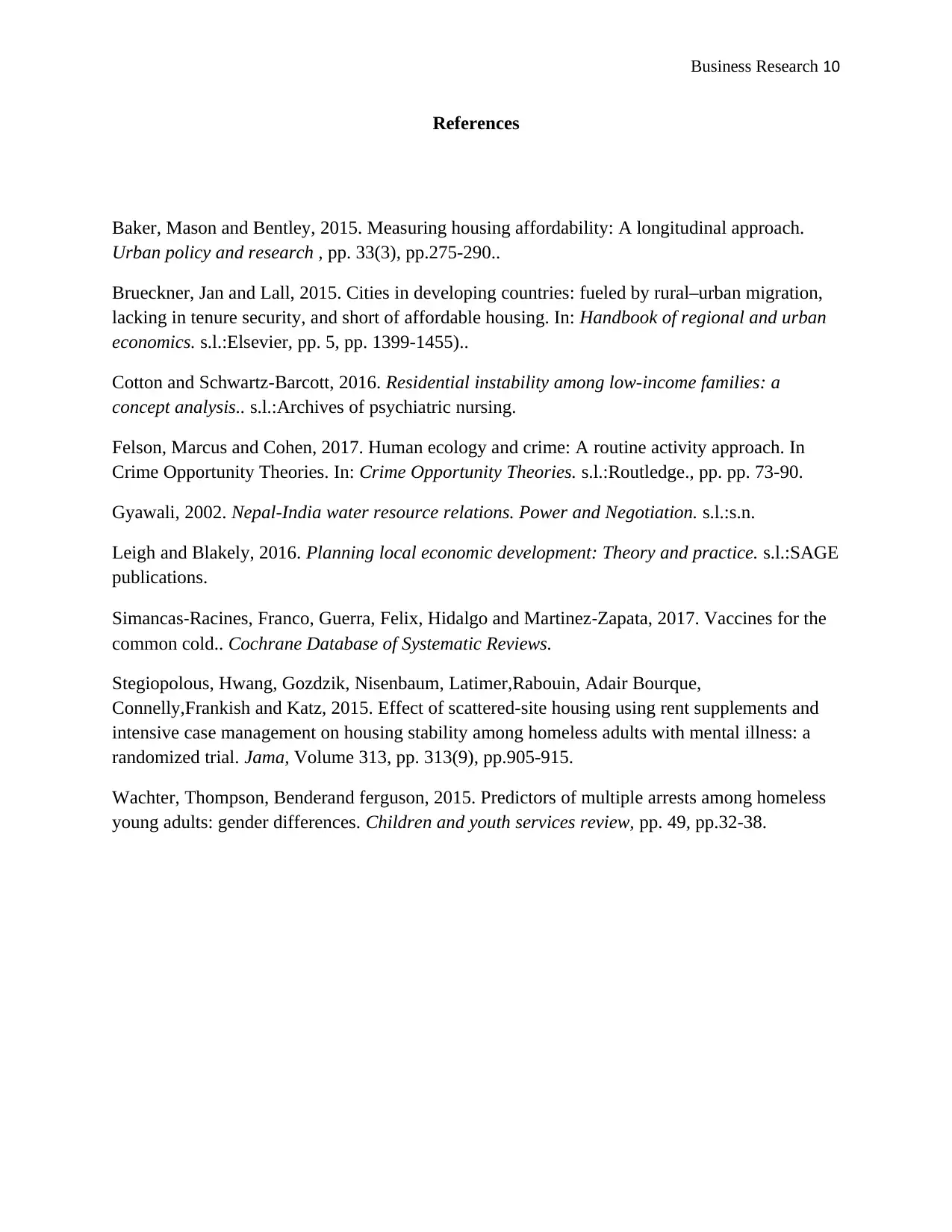
Business Research 10
References
Baker, Mason and Bentley, 2015. Measuring housing affordability: A longitudinal approach.
Urban policy and research , pp. 33(3), pp.275-290..
Brueckner, Jan and Lall, 2015. Cities in developing countries: fueled by rural–urban migration,
lacking in tenure security, and short of affordable housing. In: Handbook of regional and urban
economics. s.l.:Elsevier, pp. 5, pp. 1399-1455)..
Cotton and Schwartz-Barcott, 2016. Residential instability among low-income families: a
concept analysis.. s.l.:Archives of psychiatric nursing.
Felson, Marcus and Cohen, 2017. Human ecology and crime: A routine activity approach. In
Crime Opportunity Theories. In: Crime Opportunity Theories. s.l.:Routledge., pp. pp. 73-90.
Gyawali, 2002. Nepal-India water resource relations. Power and Negotiation. s.l.:s.n.
Leigh and Blakely, 2016. Planning local economic development: Theory and practice. s.l.:SAGE
publications.
Simancas‐Racines, Franco, Guerra, Felix, Hidalgo and Martinez‐Zapata, 2017. Vaccines for the
common cold.. Cochrane Database of Systematic Reviews.
Stegiopolous, Hwang, Gozdzik, Nisenbaum, Latimer,Rabouin, Adair Bourque,
Connelly,Frankish and Katz, 2015. Effect of scattered-site housing using rent supplements and
intensive case management on housing stability among homeless adults with mental illness: a
randomized trial. Jama, Volume 313, pp. 313(9), pp.905-915.
Wachter, Thompson, Benderand ferguson, 2015. Predictors of multiple arrests among homeless
young adults: gender differences. Children and youth services review, pp. 49, pp.32-38.
References
Baker, Mason and Bentley, 2015. Measuring housing affordability: A longitudinal approach.
Urban policy and research , pp. 33(3), pp.275-290..
Brueckner, Jan and Lall, 2015. Cities in developing countries: fueled by rural–urban migration,
lacking in tenure security, and short of affordable housing. In: Handbook of regional and urban
economics. s.l.:Elsevier, pp. 5, pp. 1399-1455)..
Cotton and Schwartz-Barcott, 2016. Residential instability among low-income families: a
concept analysis.. s.l.:Archives of psychiatric nursing.
Felson, Marcus and Cohen, 2017. Human ecology and crime: A routine activity approach. In
Crime Opportunity Theories. In: Crime Opportunity Theories. s.l.:Routledge., pp. pp. 73-90.
Gyawali, 2002. Nepal-India water resource relations. Power and Negotiation. s.l.:s.n.
Leigh and Blakely, 2016. Planning local economic development: Theory and practice. s.l.:SAGE
publications.
Simancas‐Racines, Franco, Guerra, Felix, Hidalgo and Martinez‐Zapata, 2017. Vaccines for the
common cold.. Cochrane Database of Systematic Reviews.
Stegiopolous, Hwang, Gozdzik, Nisenbaum, Latimer,Rabouin, Adair Bourque,
Connelly,Frankish and Katz, 2015. Effect of scattered-site housing using rent supplements and
intensive case management on housing stability among homeless adults with mental illness: a
randomized trial. Jama, Volume 313, pp. 313(9), pp.905-915.
Wachter, Thompson, Benderand ferguson, 2015. Predictors of multiple arrests among homeless
young adults: gender differences. Children and youth services review, pp. 49, pp.32-38.
Paraphrase This Document
Need a fresh take? Get an instant paraphrase of this document with our AI Paraphraser

Business Research 11
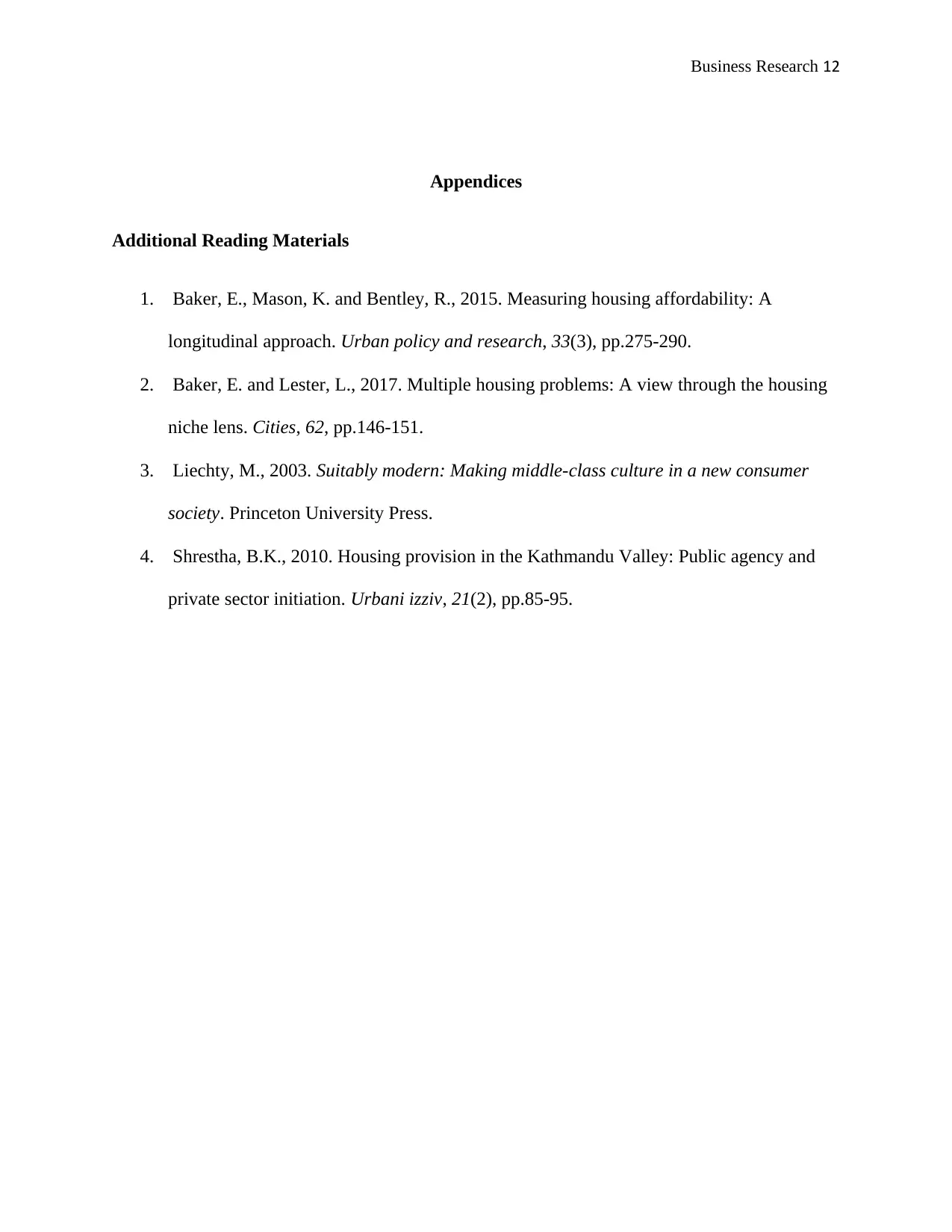
Business Research 12
Appendices
Additional Reading Materials
1. Baker, E., Mason, K. and Bentley, R., 2015. Measuring housing affordability: A
longitudinal approach. Urban policy and research, 33(3), pp.275-290.
2. Baker, E. and Lester, L., 2017. Multiple housing problems: A view through the housing
niche lens. Cities, 62, pp.146-151.
3. Liechty, M., 2003. Suitably modern: Making middle-class culture in a new consumer
society. Princeton University Press.
4. Shrestha, B.K., 2010. Housing provision in the Kathmandu Valley: Public agency and
private sector initiation. Urbani izziv, 21(2), pp.85-95.
Appendices
Additional Reading Materials
1. Baker, E., Mason, K. and Bentley, R., 2015. Measuring housing affordability: A
longitudinal approach. Urban policy and research, 33(3), pp.275-290.
2. Baker, E. and Lester, L., 2017. Multiple housing problems: A view through the housing
niche lens. Cities, 62, pp.146-151.
3. Liechty, M., 2003. Suitably modern: Making middle-class culture in a new consumer
society. Princeton University Press.
4. Shrestha, B.K., 2010. Housing provision in the Kathmandu Valley: Public agency and
private sector initiation. Urbani izziv, 21(2), pp.85-95.
⊘ This is a preview!⊘
Do you want full access?
Subscribe today to unlock all pages.

Trusted by 1+ million students worldwide
1 out of 12
Related Documents
Your All-in-One AI-Powered Toolkit for Academic Success.
+13062052269
info@desklib.com
Available 24*7 on WhatsApp / Email
![[object Object]](/_next/static/media/star-bottom.7253800d.svg)
Unlock your academic potential
Copyright © 2020–2025 A2Z Services. All Rights Reserved. Developed and managed by ZUCOL.





